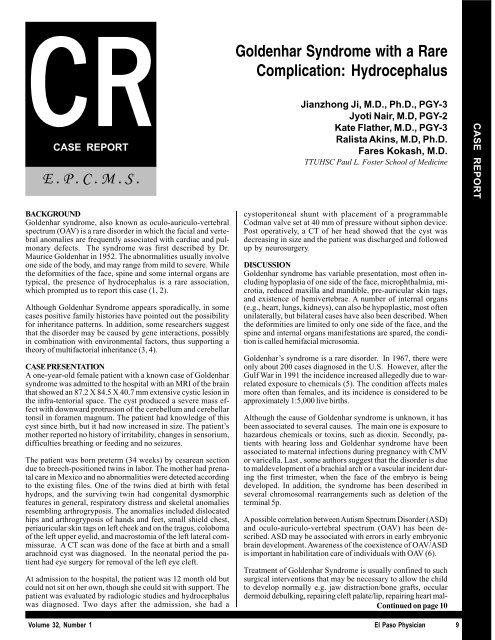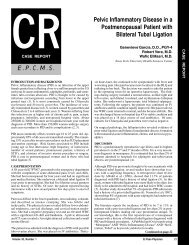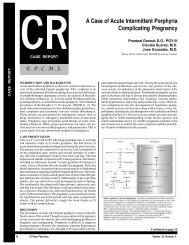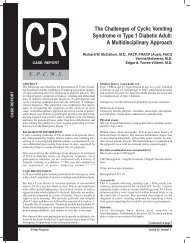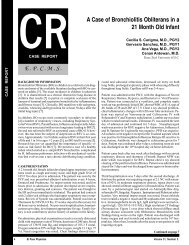Goldenhar Syndrome with a Rare Complication: Hydrocephalus
Goldenhar Syndrome with a Rare Complication: Hydrocephalus
Goldenhar Syndrome with a Rare Complication: Hydrocephalus
You also want an ePaper? Increase the reach of your titles
YUMPU automatically turns print PDFs into web optimized ePapers that Google loves.
CR<br />
CASE REPORT<br />
E.P.C.M.S.<br />
BACKGROUND<br />
<strong>Goldenhar</strong> syndrome, also known as oculo-auriculo-vertebral<br />
spectrum (OAV) is a rare disorder in which the facial and vertebral<br />
anomalies are frequently associated <strong>with</strong> cardiac and pulmonary<br />
defects. The syndrome was first described by Dr.<br />
Maurice <strong>Goldenhar</strong> in 1952. The abnormalities usually involve<br />
one side of the body, and may range from mild to severe. While<br />
the deformities of the face, spine and some internal organs are<br />
typical, the presence of hydrocephalus is a rare association,<br />
which prompted us to report this case (1, 2).<br />
Although <strong>Goldenhar</strong> <strong>Syndrome</strong> appears sporadically, in some<br />
cases positive family histories have pointed out the possibility<br />
for inheritance patterns. In addition, some researchers suggest<br />
that the disorder may be caused by gene interactions, possibly<br />
in combination <strong>with</strong> environmental factors, thus supporting a<br />
theory of multifactorial inheritance (3, 4).<br />
CASE PRESENTATION<br />
A one-year-old female patient <strong>with</strong> a known case of <strong>Goldenhar</strong><br />
syndrome was admitted to the hospital <strong>with</strong> an MRI of the brain<br />
that showed an 87.2 X 84.5 X 40.7 mm extensive cystic lesion in<br />
the infra-tentorial space. The cyst produced a severe mass effect<br />
<strong>with</strong> downward protrusion of the cerebellum and cerebellar<br />
tonsil in foramen magnum. The patient had knowledge of this<br />
cyst since birth, but it had now increased in size. The patient’s<br />
mother reported no history of irritability, changes in sensorium,<br />
difficulties breathing or feeding and no seizures.<br />
The patient was born preterm (34 weeks) by cesarean section<br />
due to breech-positioned twins in labor. The mother had prenatal<br />
care in Mexico and no abnormalities were detected according<br />
to the existing files. One of the twins died at birth <strong>with</strong> fetal<br />
hydrops, and the surviving twin had congenital dysmorphic<br />
features in general, respiratory distress and skeletal anomalies<br />
resembling arthrogryposis. The anomalies included dislocated<br />
hips and arthrogryposis of hands and feet, small shield chest,<br />
periauricular skin tags on left cheek and on the tragus, coloboma<br />
of the left upper eyelid, and macrostomia of the left lateral commissurae.<br />
A CT scan was done of the face at birth and a small<br />
arachnoid cyst was diagnosed. In the neonatal period the patient<br />
had eye surgery for removal of the left eye cleft.<br />
At admission to the hospital, the patient was 12 month old but<br />
could not sit on her own, though she could sit <strong>with</strong> support. The<br />
patient was evaluated by radiologic studies and hydrocephalus<br />
was diagnosed. Two days after the admission, she had a<br />
<strong>Goldenhar</strong> <strong>Syndrome</strong> <strong>with</strong> a <strong>Rare</strong><br />
<strong>Complication</strong>: <strong>Hydrocephalus</strong><br />
Jianzhong Ji, M.D., Ph.D., PGY-3<br />
Jyoti Nair, M.D, PGY-2<br />
Kate Flather, M.D., PGY-3<br />
Ralista Akins, M.D, Ph.D.<br />
Fares Kokash, M.D.<br />
TTUHSC Paul L. Foster School of Medicine<br />
cystoperitoneal shunt <strong>with</strong> placement of a programmable<br />
Codman valve set at 40 mm of pressure <strong>with</strong>out siphon device.<br />
Post operatively, a CT of her head showed that the cyst was<br />
decreasing in size and the patient was discharged and followed<br />
up by neurosurgery.<br />
DISCUSSION<br />
<strong>Goldenhar</strong> syndrome has variable presentation, most often including<br />
hypoplasia of one side of the face, microphthalmia, microtia,<br />
reduced maxilla and mandible, pre-auricular skin tags,<br />
and existence of hemivertebrae. A number of internal organs<br />
(e.g., heart, lungs, kidneys), can also be hypoplastic, most often<br />
unilaterally, but bilateral cases have also been described. When<br />
the deformities are limited to only one side of the face, and the<br />
spine and internal organs manifestations are spared, the condition<br />
is called hemifacial microsomia.<br />
<strong>Goldenhar</strong>’s syndrome is a rare disorder. In 1967, there were<br />
only about 200 cases diagnosed in the U.S. However, after the<br />
Gulf War in 1991 the incidence increased allegedly due to warrelated<br />
exposure to chemicals (5). The condition affects males<br />
more often than females, and its incidence is considered to be<br />
approximately 1:5,000 live births.<br />
Although the cause of <strong>Goldenhar</strong> syndrome is unknown, it has<br />
been associated to several causes. The main one is exposure to<br />
hazardous chemicals or toxins, such as dioxin. Secondly, patients<br />
<strong>with</strong> hearing loss and <strong>Goldenhar</strong> syndrome have been<br />
associated to maternal infections during pregnancy <strong>with</strong> CMV<br />
or varicella. Last , some authors suggest that the disorder is due<br />
to maldevelopment of a brachial arch or a vascular incident during<br />
the first trimester, when the face of the embryo is being<br />
developed. In addition, the syndrome has been described in<br />
several chromosomal rearrangements such as deletion of the<br />
terminal 5p.<br />
A possible correlation between Autism Spectrum Disorder (ASD)<br />
and oculo-auriculo-vertebral spectrum (OAV) has been described.<br />
ASD may be associated <strong>with</strong> errors in early embryonic<br />
brain development. Awareness of the coexistence of OAV/ASD<br />
is important in habilitation care of individuals <strong>with</strong> OAV (6).<br />
Treatment of <strong>Goldenhar</strong> <strong>Syndrome</strong> is usually confined to such<br />
surgical interventions that may be necessary to allow the child<br />
to develop normally e.g. jaw distraction/bone grafts, occular<br />
dermoid debulking, repairing cleft palate/lip, repairing heart mal-<br />
Continued on page 10<br />
CASE REPORT<br />
CASE REPORT<br />
Volume 32, Number 1 El Paso Physician 9
CR<br />
CASE<br />
REPORT<br />
<strong>Goldenhar</strong> <strong>Syndrome</strong> <strong>with</strong> a <strong>Rare</strong> <strong>Complication</strong>: <strong>Hydrocephalus</strong><br />
(Continued)<br />
formations, spinal surgery. Dependent on the severity of <strong>Goldenhar</strong><br />
<strong>Syndrome</strong>, the patient may require multiple surgeries. The facial<br />
and vertebral anomalies are frequently associated <strong>with</strong> cardiac<br />
and pulmonary defects and present a difficult technical challenge<br />
for proper anaesthetic management. (6).<br />
Children <strong>with</strong> <strong>Goldenhar</strong> <strong>Syndrome</strong> usually have a normal lifespan<br />
and normal intelligence. In some cases, special care may be<br />
needed, including hearing aid, speech therapy, orthodontic treatment,<br />
and in severe cases, plastic surgery and physiotherapy may<br />
be necessary. Pre-natal scanning may identify the condition in<br />
certain cases where facial or skeletal anomalies are present. Prenatal<br />
screening and genetic advice may be offered for future pregnancies.<br />
REFERENCES<br />
1. Hajje MJ, Nachanakian A, Haddad J. <strong>Goldenhar</strong> syndrome and arachnoid<br />
cyst. Arch Pediatr. 2003 Apr; 10 (4): 353-4.<br />
2. 2. Kumar R, Balani B, Patwari AK et al. <strong>Goldenhar</strong> syndrome <strong>with</strong><br />
rare association. Indian J Pediatr. 2000 Mar; 67 (3): 231-3.<br />
3. Touliatou V, Fryssira H, Mavrou A, Kanavakis E, Kitsiou-Tzeli S<br />
(2006). “Clinical manifestations in 17 Greek patients <strong>with</strong> <strong>Goldenhar</strong><br />
syndrome”. Genet. Couns. 17 (3): 359–70.<br />
4. M. <strong>Goldenhar</strong>. Associations malformatives de l’oeil et de l’oreille, en<br />
particulier le syndrome dermoïde epibulbaire-appendices auriculairesfistula<br />
auris congenita et ses relations avec la dysostose mandibulofaciale.<br />
Journal de génétique humaine, Genève, 1952, 1: 243-282.<br />
5. Araneta MR, Moore CA, Olney RS, et al (1997). “<strong>Goldenhar</strong> syndrome<br />
among infants born in military hospitals to Gulf War veterans”. Teratology<br />
56 (4): 244–51.<br />
6. J.L. Scholetes, F. Veyckemans, L. Van Obbergh, et al. Neonatal<br />
anesthetic management of a patient <strong>with</strong> <strong>Goldenhar</strong>’s syndrome <strong>with</strong><br />
<strong>Hydrocephalus</strong>. Anesthesia and intensive care, Vol 15. No 3, 1987: 338-<br />
40.<br />
Figure 1 and 2<br />
1 and 2. Posterior fossa arachnoid cyst <strong>with</strong> transtentorial and cerebellar tonsil herniations, associated <strong>with</strong> an acute hydrocephaly.<br />
Jianzhong Ji, M.D., Ph.D., PGY-3, Department of Pediatrics, TTUHSC Paul L. Foster School of Medicine,<br />
El Paso, Texas.<br />
Jyoti Nair, M.D., PGY-2, Department of Pediatrics, TTUHSC Paul L. Foster School of Medicine, El Paso,<br />
Texas.<br />
Kate Flather, M.D., PGY-3, Department of Pediatrics, TTUHSC Paul L. Foster School of Medicine, El Paso,<br />
Texas.<br />
Ralitsa Akins, M.D., Ph.D., Associate Program Director, Academic Assistant Professor and Associate<br />
Director of Residency Program, Department of Pediatrics, TTUHSC Paul L. Foster School of Medicine, El<br />
Paso, Texas.<br />
Fares Kokash, M.D., Associate Professor, Department of Pediatrics, TTUHSC Paul L. Foster School of<br />
Medicine, El Paso, Texas.<br />
10 El Paso Physician<br />
Volume 32, Number 1


